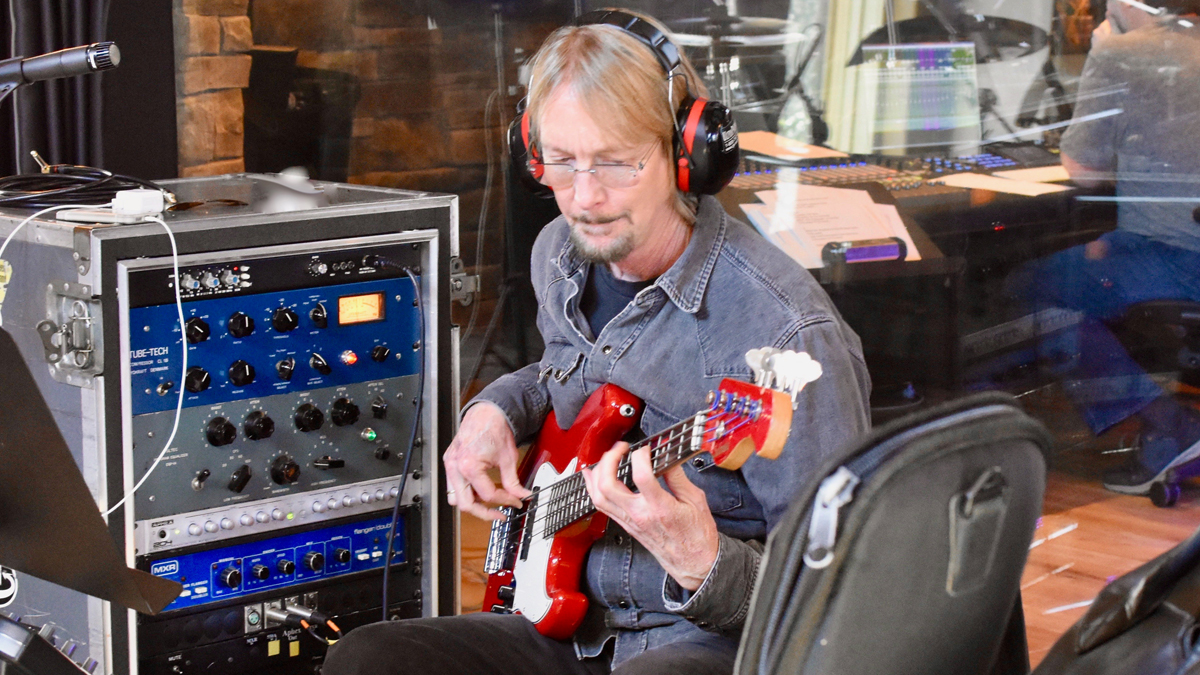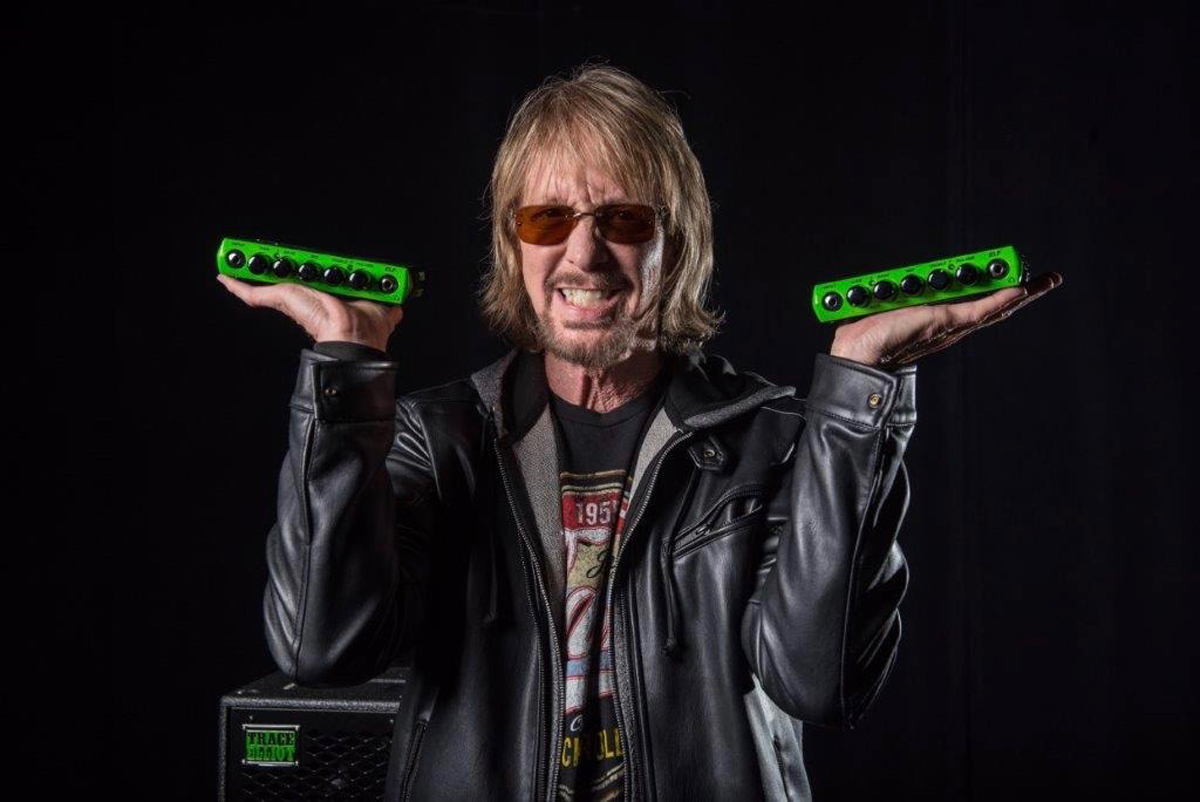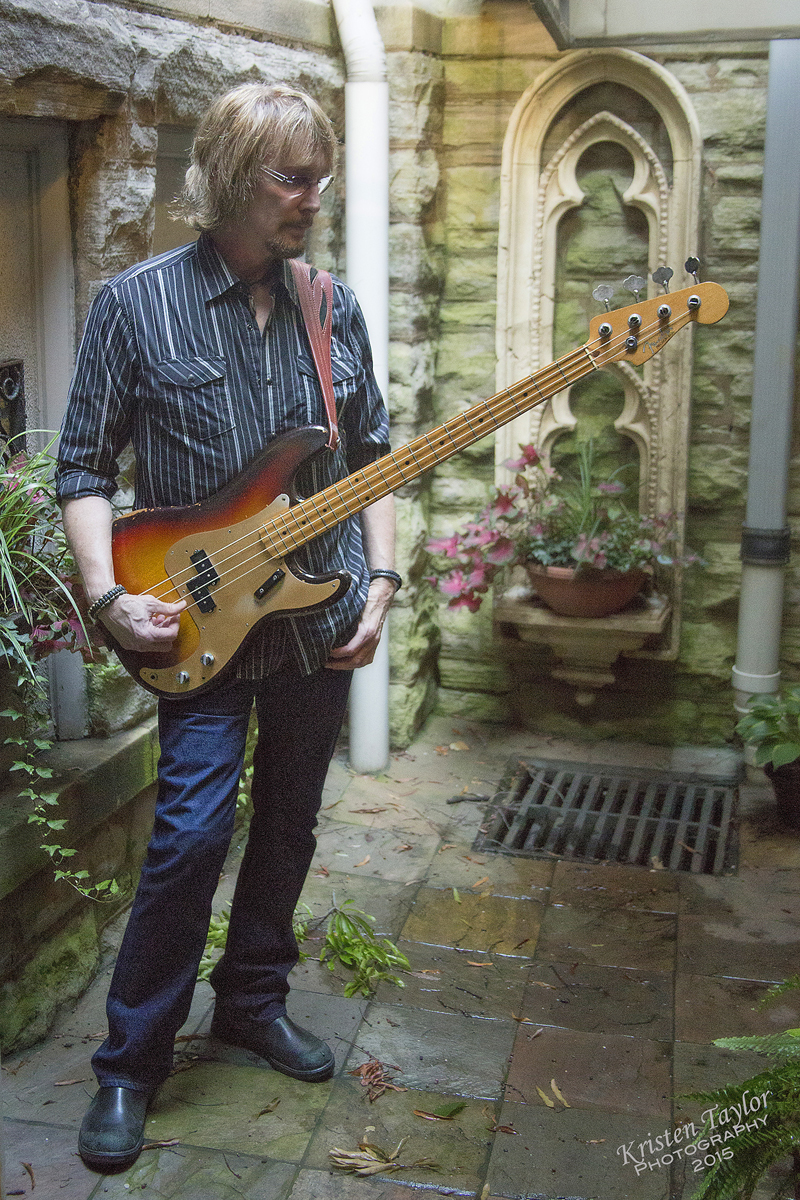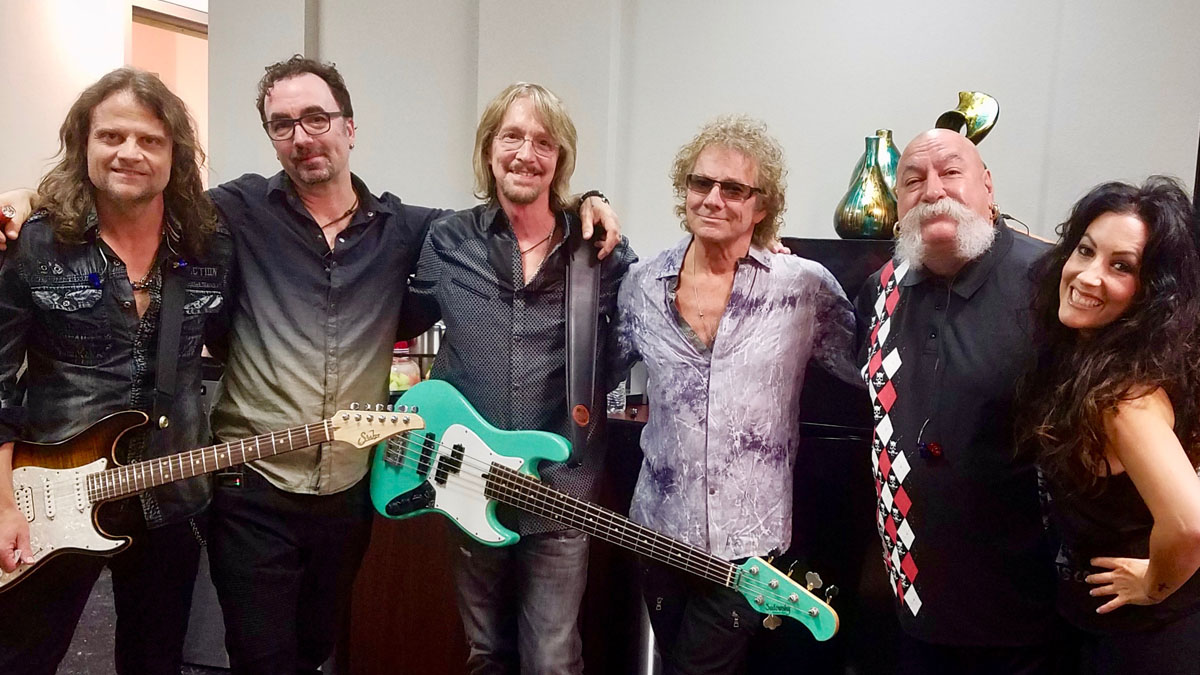Mike Brignardello's top 5 tips for bassists: “Whenever I get sick of my playing and can’t stand it, I know the way out is to practise”
Giant bassist and session pro on how your people skills can also be just as important as your chops

When bassist Mike Brignardello moved to Nashville in 1981, Music Row was known primarily, if not exclusively, for traditional country music, and the scene was rich in session work opportunities. All of this has long since changed.
The genre is now a blur of influences and instruments mixed into those roots, and the industry has shifted under the effects of technology, home recording, consumer listening habits, and shrinking revenue streams. “It’s still doable; it’s just harder to do it,” he says. “The line is longer. Even as the music business has shrunk since 2005, the pool of players has greatly expanded, so you’ve got a smaller pie and more people nibbling at it.”
His calendar remains full — five to 15 sessions a week, at three hours each, but he notes, “It’s slowed down from the roaring ’90s and 2000s, when you could do 15 a week as long as you could stand it. It was unbelievably busy. It’s backed off with the new paradigm that music should be free and all that stuff. It’s changed a bit in the last 15 or 20 years, but it’s still pretty good.”
With sessions, we typically don’t know what we’re walking into when we show up. You’ll know the artist or the songwriter, but that’s about it.
Mike Brignardello grew up in Memphis, Tennessee. After graduating high school, he became a touring musician, and during the course of those years, he joined Amy Grant’s band. His work with Grant and her producer, Brown Bannister, brought him to Nashville, where he recorded several albums with the Contemporary Christian singer before moving to Los Angeles for five years. During that time, he was a member of Giant, with guitarist Dann Huff, drummer David Huff, and keyboardist Alan Pasqua. “When the band broke up in 1993, Dann, David, and I all came back to Nashville,” he says. “Dann and I jumped right back into session playing, fast and furious. The country music wave was starting then, and we rode that thing for twenty years. It was relentless, just nonstop.”
Decades later, he was surprised to find that Giant still has a loyal following. “We worked very hard in that band, but it was just wrong time, wrong place,” he says. “Our records came out in the late ’80s, early ’90s, which was the end of the melodic-rock era and the beginning of grunge. We never really got our due back then, so it’s been gratifying to see some of that belated love come back.”
In 2008, Amy Grant re-released the album Lead Me On, on which Brignardello had played. He rejoined her band for an accompanying tour, and has toured with her every year since; 2019 will see them perform some 60 dates. He will also be on the road with country artist Trisha Yearwood in fall. “I’m going to fill in for her bass player, and I’ll be going back and forth between her and Amy for six weeks or so,” he says. “I’ve got a friend in Memphis named Jeff Adams, who plays bass with Mickey Thomas and Starship, and I filled in for him last fall for some dates and may do some more this year. I like playing live, so I do it whenever I can.”
Get the MusicRadar Newsletter
Want all the hottest music and gear news, reviews, deals, features and more, direct to your inbox? Sign up here.
Brignardello has a go-to rig onstage and in the studio. “My must-have is my Sadowsky PJ5 bass,” he says. “Roger Sadowsky, out of New York, builds these wonderful basses, and I’ve been playing them for over 25 years. No matter where I go, I’ve got one or more of those with me. I’ve also got a Sadowsky Jazz four-string that I keep tuned down a whole step. I also use a Bluesman Vintage P bass built by John Scott, in Spring Hill, Tennessee. It works every single time I pick it up. It’s chambered, very resonate, fun to play live. Like everybody else, I’ve got some old Fenders — a ’65 J-Bass and ’64 P-Bass, some specialty basses, a fretless, an acoustic Hofner, and an eight-string bass.”
He’s been loyal to D’Addario strings since 1988. “I really like the NYXL, which are round wound strings,” he says. “I use some of their flatwounds on my P-Bass and their various gauges on my 8-string. I use the Black Nylon Tapewound, which have an upright sound, on my hollowbody bass, and their upright strings.”
“In terms of outboard gear, my two pieces that I wouldn’t leave home without are an old API Channel Strip that a guy named Brent Averill did in Los Angeles years ago for me. He would buy old vintage API boards, break the channel strips out, and sell them in pairs, so I’ve got a 312 mic pre and a 550a EQ. Those two things work in all situations. And I’ve got a Tube-Tech limiter. If I could add more stuff to that, I’d add an old Pultec EQ that I love.”
“When I just need to show up with a bass and a pedalboard, my Cali 76 1176 is one of the main things on my board because it’s a big part of my tone. I love the way it sounds. And I have the normal pedals — a Fulltone distortion pedal, an EBS octave pedal, and a little Boss EQ that I send to Analog Man, where they go through it and make it professional grade.”

Brignardello's amps and cabs are all Peavey. Playing theatres and smaller venues with Amy Grant, he uses the Trace Elliot ELF and a Trace Elliot 4x10.
“When I do bigger venues, I have an old Trace Elliott AH500, which they don’t make anymore,” he says. “I use that amp head with a Trace Elliot 4x10 and 1x15 cab, stack it up, and that’s my go-to set. When I’m gigging around town, I take my ELF and a Trace Elliot speaker cabinet with a 2x8 or 210 for club gigs. I’ve been using the ELF since they first started making them. I have three of them — two I take on the road, with one for backup, and one I keep with me and use it around town. The thing I like about the ELF is that when I plugged it in, I literally did not twist one single knob and I loved the tone that I got out of it. I’ve probably gone to gigs where I’ve done exactly that: just plugged it in and turned it on.”
“I’ve lived my whole life as a sideman,” he says. “I’ve been in bands, of course, but the vast majority of my career has been as a sideman, so whatever tips I have, I look at it through that lens, as a hired gun.”
1. Be prepared
“My number one tip would be preparation. You have to keep yourself in a constant state of readiness in terms of ability, gear, and chops, because you never know when you’re going to get a call out of the blue for an audition, a session, a gig, a tour, anything.
“When I got the call last August or September to do some dates with Mickey Thomas and Starship in October, I said, 'Great! Can you send me something?' Of course, I didn’t get a thing! So I tried to guess which songs they would do. I found current performances on YouTube and started learning the 2018 versions. I eventually got a tape, but I’d done a ton of legwork prior to that, because when they called me, I said, 'Will we get a rehearsal?' 'No.' 'Will we get a long soundcheck?' 'No.' I said, 'Could I have an iPad or use some cheat sheets?' 'No.' It’s basically show up cold and know the set. I had a great time; the band and Mickey Thomas killed it every single night, and I’m looking forward to doing more whenever my pal Jeff needs me.
“With sessions, we typically don’t know what we’re walking into when we show up. You’ll know the artist or the songwriter, but that’s about it. You may get some information from the person who books you, but that’s rare. Sometimes you cannot prepare for a specific gig, but you can prepare yourself to be ready for whatever happens.
"Decades ago, when Dann and I were starting out, he said, ‘There are a lot of guitarist better than me, but nobody’s going to show up better prepared than me.’ Of course, he was being really self-effacing, because there weren’t many people better than him! But he had that work ethic that he was going to be ready, and it really stuck with me. There’s a ton of people out there better than me, but I’m going to try to be as prepared as anyone can be for whatever I’m walking into.”
I’ve seen so many musicians get frustrated by taking things too literally. It’s our job to interpret what artists and producers tell us.
2. Practice is the bedrock
“Practice is part of your preparation. It’s not all of it, because a lot of preparation is a mental game – keeping your head on straight, all those kinds of things. But practising, to me, is the bedrock of preparation, and practising cures a lot of ills. A lot of musicians go through cycles of inspiration and staleness. I know I do. Whenever I get sick of my playing and can’t stand it, I know the way out is to practise. Once you sit down and start learning things you don’t know, you can practise yourself out of a rut. Everybody knows it, but you sort of forget it.
“The other thing practice does is it keeps you mindful of your strengths and weakness. Everyone wants to play the songs they know and their favourite licks, but if you really practise, if you really get down on it, it keeps you focused on what you need to be improving at the moment. The thing all musicians know is that you’re always on the path and you will never arrive. There’s always something more to learn, which is the beauty of music. You’re never going to know everything. There’s always something to dig out, and if you think you know everything, get on YouTube and look around at what some of these people are doing. That’s always humbling for me, and it helps me remember that whatever I know, there’s a thousand times more to learn.
“So even though they're two separate things, and you have different methods for the way you prepare and the way you practise, to me, they’re linked together.”
You think about the old Motown stuff — James Jamerson is a huge idol of mine, and I still love listening to his lines. That guy had one bass. It was what he played, not the gear.
3. Gear has its place — but not everyplace
“I’ve always looked at gear as a double-edged sword. It won’t make you good, and it won’t get you knowledge, but it will inspire you to want to practice more. Everyone knows how great it is when you get a new instrument. You don’t want to put it down. You hear new tones that lead you to something else. The same with outboard gear and the different sounds and effects. But you can go down the well with gear and get so sidetracked with what it can do that it’s easy to forget that it’s just a tool in your arsenal.
“I’ll give you an example. When I was a really young guy, I saw a Hagstrom eight-string bass and I thought it was the coolest thing. Decades go by, I get a chance to buy one, and it’s OK. It’s old technology, it’s hard to get it in tune, but I’m really enamoured with this thing, I’m playing it all the time, it’s my new girlfriend, so to speak. I haul this bass around for a year to every session I go to, saying, ‘Look at this! Listen to this!’ And the producer immediately says, ‘Yeah, that’s great. What else have you got?’ This happened over and over until finally I realized that the only person who is so enamoured with this bass is me.

“I still have it, I love it, I love playing it, but everything has a space. You’ll have an opportunity to use that gear, but you’ve got to know where and when to pick your moments. For what I’m doing, nine times out of ten, they don’t want a pedal and they don’t want a wacky sound. They want good tone and a good part. You think about the old Motown stuff — James Jamerson is a huge idol of mine, and I still love listening to his lines. That guy had one bass. It was what he played, not the gear."

4. Learn how to coexist
“We have a saying that when people come in to audition for a band, half the audition is the ability to ‘ride the bus.’ It’s totally true. I would venture to say that more than fifty percent of a touring gig is the ability to live peacefully together and get along. Many bands have been ruined by one knucklehead. That knucklehead makes for a really long bus ride or tour, and you don’t want to be that guy. You’ve got to be able to coexist and be a decent human being, know what your duties are, where your spot is, and be able to ‘ride the bus.’
“I’ve seen many superior musicians who weren’t called back because of their lack of people skills. It’s not as overt during sessions as what you can see in a touring situation, but people who resist being produced, who resist taking suggestions, soon weed themselves out. If a producer has to coax you into doing his idea, he’d rather hire someone who would do it gladly.”
In Nashville, the recording process is very collaborative. The producers and artists don’t have every lick and hook written out; they’re relying on the musicians to do that.
5. Read the room
The next important skill wouldn’t be my knowledge of scales. It would be how to read the room. I’ve seen so many people hurt themselves because they couldn’t do that. Whatever the situation – an audition, a tour offer, or a three-hour session – you’ve got to have enough people skills to size it up right away and figure out what’s going to fly and what’s not.
“The other part of that is a little of a different skill. It’s mindreading. Twenty-five or 30 years ago, I’m in LA with Dann, who was the top session guitar player out there, constantly busy. One afternoon I tag along to a session. It’s a famous producer, he’s going around the room and telling everybody what to do, and it’s the stupidest thing I’ve ever heard. He’s telling this legend and that legend what to do. He gives Dann instructions and Dann nods. I listen and I tell Dann, ‘That will never work.’
“They did the take, Dann didn’t do anything even remotely close to what the producer suggested. He came out of the control room and said, ‘Dann, that was perfect! That’s exactly what I asked for!’ As we left the studio I asked, ‘How did you do that?’ He said ‘Do what?’ I said, ‘He asked you to do XYZ, you said you would, you did nothing of the sort.’ He says, ‘Oh, man, that obviously wouldn’t work!’ Of course Dann is an amazing musician, but he reads minds better than anyone I’ve ever seen. I believe that’s one of the reasons he’s such a successful producer.
“Artists typically know what they want, but communicating it effectively and being able to speak ‘musician–ese’ is not their thing. A lot gets lost in translation. ‘I want it more blue,’ ‘Man, I want this to rock,’ ‘I want this to be organic’ are our typical instructions. Of course, those things mean something different to every soul on the planet. So it’s being able to say, ‘OK, man, I gotcha,’ and then follow your musical instincts. I’ve seen so many musicians get frustrated by taking things too literally. It’s our job to interpret what artists and producers tell us.
“In Nashville, the recording process is very collaborative. The producers and artists don’t have every lick and hook written out; they’re relying on the musicians to do that. We can arrange on the spot, maybe tweak a bridge, write an intro, or an outro. They depend on the musicians to help flesh the song out. And I love that we’re allowed that much input. It sure is a fun way to make records!”









